|
Little has been published about U.S. actor and media personality Alfonso Ribeiro’s Trinidad-born American parents - Michael, a correctional officer, and Joy Ribeiro - or his grandparents, including his paternal grandfather Albert Ribeiro who was a calypsonian known as Lord Hummingbird.
Inaccurate information on Wikipedia and elsewhere states that his parents were from the Dominican Republic and his grandfather was calypsonian Roaring Lion. Ribeiro, however, has sought to correct this in a number of media interviews, confirming that his grandfather was Lord Hummingbird. In addition, on his Instagram page @therealalfonsoribeiro, Ribiero provided a glimpse of his family. Over the years, he posted separate photos of his father, mother, and grandmother, as well as one with his wife, Angela, at Trinidad Carnival. Ribeiro is best known for the character Carlton Banks which he played on the hit television show Fresh Prince of Bel-Air and as host of America’s Funniest Home Videos. He is quoted as saying, “I’ve got great memories of being in Trinidad. As a kid, we went every summer. That was always amazing. I’ve got great memories. I’ve obviously gone back as an adult many times to play Carnival. I even took my then fiancée, now wife, and we played Carnival and Bliss. I’ve absolutely enjoyed all my Trinidad connections, and it has been wonderful.” (Source: Dominic Kalipersad, May 26, 2022)
0 Comments
Growing-up in Belmont in the 1940s was a pleasurable and memorable experience.
At the end of World War II, Belmont,like other parts of Port-of-Spain experienced the resurgence of Steelbands. After an absence of more than five years ,Steelbands took to the streets on VE Day, May 8th,1945 and later on VJ Day and the Celebrations of the end of World War II. on August 14th ,1945 The early Belmont Steelbands were Rising Sun and Sunland,and later Stepyard, Dem Boys ,Dem Fortunates, Dixieland,Tropitones,Stromboli,Chetniks from Gonzales and Bataan from Olton Road. There were other smaller Steelbands. Rising Sun ,was under the leadership of champion soloist Dudley Smith, a member of TASPO,with Flagman“Arthur Tramcar”Andrews. In later years , Prior Drakes a “Belmont boy” became the flagman for Invaders and in the 1970’s ,Dr. Ashton Parris another “Belmont boy” became the Manager of Invaders and arranged for Invaders Steelband to visit Washington D,C. The first popular flagwomen were Yvonne “Bubulups”Smith and Mayfield Camps, both from the “Hell Yard” Steelband of 102 Charlotte Street. “Hellyard Steelband” in later years was named “Neal and Massy All Stars” Steel Orchestra. Home of the Tropitones Steelband,which included many St.Mary’s College students,was the Thompson’s backyard in Darceuil Lane. Tropitones caused quite a stir when “dem white boys” first appeared on the streets one Carnival Monday. Four of the Thompson boys became Captains with BWIA, and five of their sons are qualified pilots. I remember the J’ourvert morning when the revellers in Rising Sun, many waving small tree branches, were chanting an African Song (possibly an Orisha chant) as the band proceeded to down-town Port-of-Spain,as was the tradition. On Carnival Monday nights,the Belmont boys travelled to Woodbrook to “jump-up”in Invaders, where the girls were. The girls were always chaperoned by an adult family member. Mas men from Belmont included Harry Basilon, Harold Saldenha, Jack Brathwaite, and later Wayne Berkeley, celebrated metal crafstman Ken Morris, Fancy Sailor Band leaders Jim Harding ,and his protoge Jason Griffith. Popular Old Mas Bands were William “Sheppy” Shepherd, Keto Rodriguez, John Mollenthiel ,the Darceuils with Carl Blackman and Hugh Hill. Popular “Monday Mas Bands” were “Borroquites” of Bel Eau Road and the band led by John Mollentheil. I remember the occasion on which “Dem Boys” Steelband produced a well-received Costumed band , named “Viva Zapata”. Important Belmont personalities included Sir Ellis Clarke,who became the President of Trinidad and Tobago,Sir Hugh Wooding.Sir Alan Reece, Sir Lennox O’Reilly(born in St,Lucia), Politicians Albert Gomes,Francis Prevatt, Anthony Jacelon and Frank Stephens, Commissioner of Police, Jim Rodriguez, Dr.Steve Blizzard, Harold and Kwailan La Borde, Edric Connor, High Court Justices Monica Barnes, James Davis, and Gorge Collymore, Dr.Harry Collymore, Professor Ken Julien, Professor Harry Phelps,Dr.Ralph Phelps, Kathleen“Auntie Kay”Warner, Dancer/ Choreographer Jean Coggins, Julia Edwards the Limbo Dancing exponent, and Kenrick Barnes ,who became a Colonel in the Jamaica Regiment,and was posted to London as the Jamaican Government’s Military Attache.(not verified) . He was the father of John Barnes, who represented England at Soccer on numerous occasions. The best known Sports Clubs were Everton F.C.(1929-1933), Colts F.C.,Dynamos, Summerville,Belmont Dodgers, Luton Town F.C., Riversdale, Siwel and Cricket Clubs Shannon and Stingo,the Belmont Orphanage Boxing Gym under J.M.Douglas, which produced Boswell St.Louis, Easy Boy Francis and the West Indies champion “Gentle Daniel” James. Sport personalities and athletes included J.R.N.Cumberbatch ,Eric Pierre,and later Basil Ince and Edwin “Pee-Wee”Roberts(two-time Olympic Bronze Medalist),in athletics. Alfred Charles and Arthur Maynard ,the legendary Everton F.C. back-line. In 1937,Alfred Charles became the first Trinidadian soccer player to play as a professional in England, Shay Seymour of Colts F.C.who also played professionally in England for many years, Geoff Chambers of Maple Club and coach of Dynamos F.C., Alan Joseph,who played as a professional soccer player in Venexuela, Horace “Pepper-wine” Lovelace, and Conrad Brathwaithe, Matthew Nunes who also played for a brief period as a professional in England, and Pat Gomez, the latter three were members of the only West Indies Soccer Team which in 1959 toured in England. Pat Gomez was the Captain of the team. In cricket Belmont had Arthur Maynard ( Full-back of Everton F.C.)who scored 200 n.o. in his only International Cricket match. The Captain of the Trinidad Team, Rolph Grant, had declared the Trinidad Inning closed and thus deprived Maynard ,then on 200 n.o.,of the opportunity to become the batsman with the highest run score at the Queens Park Oval, then held by Patsy Hendren of England ,with a score of 205. Then we had Andy Ganteaume who scored a century on his maiden and only Test appearance for the West Indies, Brian Davis, Charles “Charlie”Davis ,who scored a Century at the Lords Cricket Ground in London, Kenneth “Kenny” Roberts, Andrew Clarke, and Simpson Guillen ,who represented both the West Indies and New Zealand at Test Cricket. I was unable to verify whether Clarence Skeete ,who represented Trinidad at Cricket, was a “Belmont boy”. We had Professional Wrestler “Golden Ray Apollon”, soccer and boxing referee George Cumberbatch, Harrison Skeete, the World’s Masters Weightlifting Champion for 18 consecutive years, until his retirement at age 82 (inducted into the World’s Hall of Fame of Masters Weightlifting), Mervin “Pee-Wee” Wong, a celebrated Cricket statistician and “Kanaka” the grounds-man who prepared matting wickets on the Queens Park Savannah,( At that time ,Cricket was played on Matting Wickets . There were no Turf wickets in Trinidad at that time). In Cycling we had Cecil Phelps ,Leslie King , and Barlow (St.Vincent),in Rifle Shooting(Bisley) Charles and Frank Lassalle, Gerald Stewart and “Jackie” Wilson,in Amateur Boxing Louis Barradas,Stunt Cyclist Gregory, Carl Blackman in Basketball and James Jackson and Timothy “Timmy”Patino in Race Walking. Netball playing ladies included, the Bernard sisters, Rita and Phyllis, the Williams sisters, Jessica Smith, Dulcie Bowen, and Eileen Clunis. In Hockey we had the Fernandes sisters, Joyce, Jean and Paddy,Nola Boisselle, Irma Davis, Vilma Spencer and the Richards sisters. There may have been “stars” in other sports whom I do not remember. Doctor’s offices in Belmont were Dr.Sam Carter, Dr.Brown, Dr.Hayes and Dr.Cyril Joseph,the father of Champion wrestler“Golden Ray Apollon”. In those days ,doctors made “home visits”. There were no Dentist’s Offices in Belmont. The Lambie’s dentist was Dr. Farrell, with his office being located on Duke Street. Churches and places of worship included, St.Francis R.C.,St.Margaret’s E.C.,Belmont Methodist, Gospel Hall, the Wesleyan Church, and the Rada Community on Belmont Valley Road. Belmont Schools were : Belmont Boys’ Intermediate(de Four), Providence Girls’(Sister Aloysius) , Haig’s Girls High School (Miss Graham), Belmont Boys’R.C.(Caesar), Belmont Girls’ R.C.(Miss Pollard and later Miss Luke), St.Margaret’s Boys’ E.C.(Maynard), St.Margaret’s Girls’E.C.(Melville Memorial),Belmont Methodist(Collymore), Ideal High School ( Ellis),originally at Oxford Street before relocating to Jerningham Avenue in the 1970s,Modern Academy(Mitchell) and St.Thomas High School (Young). Some of the Belmont “boys” and “girls” who became priests or nuns, and whom I remember, include Frank Caesar, who is a Canon of the Anglican Church , Raymond Reid, Michael “Mikey” Pascall, who left the Priesthood,got married and migrated to Canada sometime in the late 1970s. On an occasaion , Father Pascall brought his “Old Mas” Band from Cedros and Icacos to “play mas” in Port -of-Spain. Also remembered were Cyril “Hook”Ross, Albert Clarke and his brother Hillary Clarke, Rex de Four,Carlton Hoskins, Monsignor Christian Pereira, the R.C.Cathedral’s Administrator and Vicar General, his brother John Pereira, the Abbot of Mount St.Benedict Monastery, Maria Clarke, Sister Paul ,who is the sister of Albert and Hillary Clarke, and Aloysius Ashby, Sister Aloysius, who became the Principal of Providence Girls Catholic School. There may be others whose names I do not remember. Boyhood activities included the traditional games of Football and Cricket, of pitching marbles, flying kite, and “spinning top”. There was roller skating on the streets, backyard table tennis ,and weightlifting. Some of the boys “ran jockey” in the Dry River. During the Rainy Season, bathing in the rain was a habitual and enjoyable practice. Many boys kept tropical fishes, pigeons or rabbits which were fed with grass called “rabbit meat” and with vegetable skins from the kitchen. This was an inexpensive method of converting waste into edible protein. Saturday morning activities included cycling to Blue Basin in Diego Martin or to Dean’s Bay in Carenage. During the “mango season” it was visiting upper Belmont Valley Road “for mango”. The land owners on whose lands the mango trees grew, were tolerant with the trespassers on their lands. Today these lands are all covered with houses and access roads. Another week-end activity was catching fresh water fishes ,Guppies “millions”,Coscorob, and Hart’s rivulus or“jumping guabines”, in the upper and then unpaved section of the St.Anns River. A Saturday alternative was the 9.30 am or the 1.30 pm.movie show at the Olympic Cinema on Erthig Road or at the Royal Cinema on Observatory Street, where the Admission fee was one penny. During school vacations children were given a “clean-out”,using a “bitter-tasting”tisane made from senna leaves, “worm grass”, and other medicinal herbs. Our Sunday mornings, after church, were often spent playing cricket, kicking ball or flying kite in the Queens Park Savannah. Sunday afternoons were for casual strolls on the“Pitch Walk” around the Savannah and in the Botanical Gardens, meeting with girl friends, purchasing peanuts from “Mile-a-Minute”or listening to music rendered by the Police Band, under the baton of the conductor Major Rupert Dennison. A tramcar ride around the Savannah or the purchase of an Ice Cream cone for your girlfriend at the Queens Park Cafe was a proud moment. A visit to the Trinidad Dairies on Phillips Street for a Banana Split or a Sundae was a great accomplishment. Another enjoyable activity was attending the Police Band Concerts at the Botanical Gardens on moonlight nights. What a fun time for all teenagers,boys and the girls who were always chaperoned. The Cocorite Swamp was not too far away to cycle when “crabs were running”. In 1972 reclamation of the Cocorite Swamp was commenced, houses were constructed and the area was named Westmoorings. Belmont was a true community which had developed over many generations. There was respect and love for each other and assistance was always available whenever needed. Before 1941 and the arrival of “Small Islanders”, mainly from Grenada, and St.Vincent and the Grenadines, to work on the construction of the US Bases at Chaguaramas, at Cumuto (Fort Read and its Waller Field Air Force Base) and smaller Airstrips in Central Trinidad( Edinburgh, Camden and Carlsen ) , there were few newcomers to Belmont. Published in the Trinidad Newsday Newspapers in May 2014 . Revised on 10th July,2022 Ian Lambie Please appreciate that the above has been written from a rusty 89- year old memory. With most of my potential resource persons having already departed and with no one to assist me, I am hereby requesting that you forgive any omissions and inaccuracies which you may detect. (Source: Ian Lambie, July 26, 2022) I spent my first twenty-three years resident in Belmont with my parents and siblings before relocating to Woodbrook in 1956. Nevertheless ,today, more than fifty-seven years later ,I still have a special affinity for Belmont.
Belmont has always been a residential area with the majority of residents being middle income Public Servants, office and store clerks and low income blue collar workers,with a smattering of upper middle income households in the north of Belmont. Up to that time the majority of houses were mainly wooden structures with a Main House on pillars and a detached kitchen at ground level . It was only in the 1940s that running water,water closets and wash basins,were installed in new houses with the Main House, kitchen and occasionally a laundry room being built on the same level.. Most fireplaces were wood burning while some persons used coal-pots for cooking and baking. Kerosene stoves first appeared in Trinidad in the 1940s and cooking with electricity and LPG was introduced much later. Household refrigerators, washing machines, vacuum cleaners and electrical kitchen appliances had not yet arrived. Tap water was not available in the Main House and the shower was often an enclosed cubicle in the backyard enclosed using galvanise-sheeting. There were no water closets. The facility was a pit latrine located some distance from the other buildings and there was no toilet paper. Discarded newspapers were used. In some living rooms of many Roman Catholics, hung a photograph of the Sacred Heart, Pope Pius XII, Jesse Owens, Joe Louis ,Haile Selassie and occasionally of Learie Constantine. Without household refrigerators,the matriarch ensured that there were not much “left-overs”, and whatever there was,it was placed in a “safe” enclosed with fine meshed wire. Occasionally, for preservation, meats were smoked and fish salted and dried,“taza sale”. The washing of clothes was manually performed using a wooden tub, cut from a pickled meat barrel,and placed in the back-yard,with a “jooking board”,and with blue,brown or Sunlight soap was used. There were no powdered detergents,or liquid bleach. The addition of Keens oxford blue made the white clothes whiter. In the backyard there was a mound of stones for “bleaching” the white clothes and a line for sun –drying. Many backyards had one or more mango, zaboca, breadfruit, guava,sugar- apple,sour-sop, lime or plum trees,the fruit of which was shared with the neighbours. Occasionally there was a large tambran (tamarind) or chenette tree in the yard. There were “yardie” fowls.”clean-neck”, or “frizzle”, and Muscovy or “canal” ducks. Frozen chickens were yet unknown. It was not unusual to see an old chamber pot (pozee) containing an aloe plant on the dog house,if there was one. In the 1940s the primary mode of transportation was walking, riding a bicycle or using the Tramcar which was in service until 1954. From 1941 to 1958, Trolley-buses ran the Belmont-South Quay route. At the Transfer Station,located at the corner of Park and Frederick Streets, a commuter could transfer to a tramcar going to Four Roads,Diego Martin, or to a Woodbrook/St.James Trolley-bus. Around 1945 the “six-cents taxi” emerged ,and one of the popular drivers on the Belmont/St.Vincent Street route was Eugene Ducurew ,with his blue Ford Consul,Registration No. P 666. Another six-cents taxi driver was Boland Amar, who later became a successful businessman and agent for Toyota Vehicles. Lunches were conveyed on foot, by pipe-smoking“Lillian”,from homes in Belmont,to reach the “breadwinners” at work “down-town”, before noon. Christmas was the most significant season of family togetherness, feasting and merriment. The house had to be thoroughly cleaned. The exterior house walls and the fence “white washed”, using coloured ochres for colour and the woodwork painted. The furniture had to be polished and floors had to be scrubbed or polished using “Mansion” Floor Polish and shined manually. New curtains had to be sewn and hung, and linoleum purchased for the kitchen floor. Occasionally an imported Christmas Tree, cut from a live tree, was purchased from Grell and Company. These trees imparted the “Christmas smell” to the house. Residents ,and visitors to the neighbourhood, extended “Merry Christmas” Greetings to everyone and not the recently “copied” “Happy Holidays” Greetings from the USA. To us in Trinidad ,Christmas was and continues to be about celebrating the birth of Jesus Christ. We erected our creches at home and in later years a Public Creche was erected on “the greens” at the junction of St.Anns Road and Circular Road during the Christmas Season. The Christmas ham was a dried and smoked pork leg or shoulder, encased in a tar jacket. After removing the jacket it was boiled in a “Pitch oil tin” placed on three bricks,over a wood burning fire in the backyard. It was then decorated with cloves. Another meat was often baked chicken or turkey, and a baked leg of pork,when affordable. The Christmas cake,was always a black fruit cake, made with fruit steeped in rum for many months,and baked in a galvanise “box” placed over a coal pot fire. In country districts, mud ovens were still used for baking. Making pastelles was a Christmas tradition, as it continues to be, and all members of the family participated in its preparation. Today many caterers prepare pastelles for sale. Today, pastelles are available from Trini caterers in those parts of the USA and in Canada where there is the demand from Trini residents. Christmas beverages were sorrel, ginger beer, ponche-de-creme, cherry brandy, falurnum, vermouth rum, beer, with gin and whisky, when affordable.(Vodka was yet unknown in Trinidad). Apples, pears,and grapes were luxury items available only at Christmastime.(No Air Freight as yet) I cannot recall whether other exotic imported fruit were available. Danish biscuits,chocolates,walnuts,brazil nuts and almonds were served. A block of Ice was often stored for use in an “Ice –box”outside of the building. A traditional early Christmas Morning function was the opening of the Christmas gifts by the children of the house onthe return home after attending “Mid-night Mass”. Boxing Day was a big day,with horse-racing at the Queens Park Savannah. It was a day for picnicking with family and friends from the country, who had travelled to Port-of-Spain, by bus or by train, for the occasion. They did not own vehicles in the 1940s. There were games of chance which included : “Alipang in de bag”, “Over and under the Lucky Seven”, throwing hoops over bottled beverages and the “Three Card” game. Occasionally there was a “Merry-go-round”,and a “Ferris Wheel” erected on the nearby Princes Building grounds. Everyone enjoyed this annual “get-together” of camaraderie and fun. I am confident that the “Senior Citizens” who read this will have happy memories of these wonderful occasions which they enjoyed,with family members and friends, as I have. (Source: Ian Lambie, Juy 24, 2022) 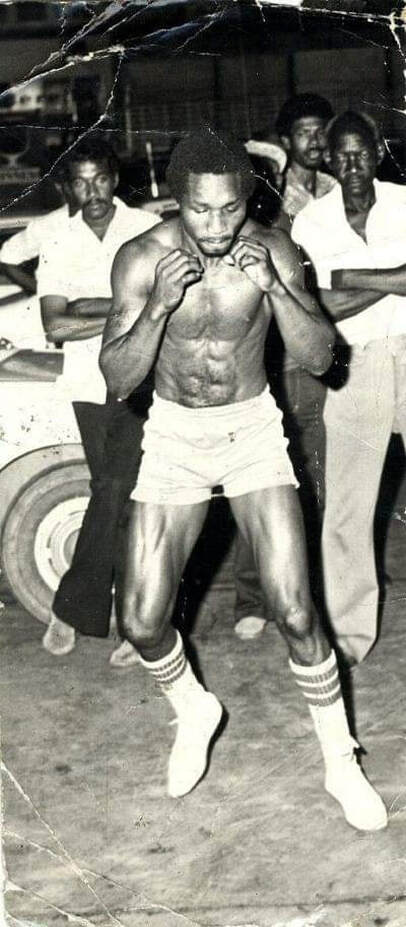 this country’s first World boxing champion!!! Claude is now 74 years old! Claude Noel (born 25 July 1948) in Roxborough, Tobago) is a former Tobagonian professional boxer. Former 3 time Commonwealth and World Champion Claude Noel, 31-10, 15 KO’s, had a career span from 1973-1984. His rise from selling fruit as a teenager to making waves in boxing is as simple and as recognizable as any outside of the Caribbean. Noel’s fighting career began when at school he seemed to always be fighting with other boys. Because he was spotted at an early age, he was advised to get some lessons – he did and then channeled that aggression in a more positive direction. Noel shot to world acclaim when he defeated Mexican Elgato Gonzales in 1982 for the World Title in the lightweight division. Following his victory, he was later honoured with the Chaconia Gold Medal and had a highway named after him in his native Tobago. Noel now resides in Trinidad. He has been undergoing severe health challenges but is continuing to keep the fight. For his last birthday, a post was dedicated to Claude celebrating his birthday on August 22nd, 1949 but was corrected by family as being July 25, 1948. The latter date is widely published online as the boxers birth date. (Source: Vitrual Museum of TT, July 26, 2022) On July 13th, renowned Trinbagonian novelist, playwright and journalist Earl Lovelace celebrates his 87th birthday! He is known for his highly-awarded literary career that has spanned five decades, producing works such as: “The Schoolmaster” (1968), “The Dragon Can’t Dance” (1979), and “Salt” (1996) which was the winner of the Commonwealth Writers Prize in 1997.
Born in Toco on July 13th 1935, Lovelace was sent to live with his grandparents in Tobago until age 11, when he rejoined his family in Trinidad in 1946. As a young man, he worked as a proofreader at the Trinidad Publishing Company, followed by jobs with the Department of Forestry and the Ministry of Agriculture as a forest ranger. These positions gave him an inside look at what life was like in the more rural areas of Trinidad, which he then utilised in his writing. Lovelace’s books are distinct because as a native writer he covered topics indigenous to Trinidad and Tobago, such as Carnival, colonialism, and the banning of Spiritual/Shouter Baptists. His 1982 book, “The Wine of Astonishment” was written entirely in Trinidadian dialect. His first novel, “While Gods Are Falling”, was published in the United Kingdom in 1965. Lovelace moved to the United States the following year to study at Howard University, and in 1979 he published his third novel, the acclaimed “The Dragon Can’t Dance”. He also wrote its stage adaptation, and his work as a playwright continued during the 1970s, publishing, “My Name is Village” (1976) and “Jestina’s Calypso” (1978). Lovelace is also an accomplished newspaper columnist and university lecturer, having lectured in Literature at numerous universities abroad and at the University of the West Indies, St. Augustine. For his work, Lovelace was awarded a Guggenheim Fellowship in 1980, the Chaconia Medal (Gold) in 1988, and an honourary doctorate from the University of the West Indies in 2002. This photo is courtesy of the Trinidad Guardian Newspaper, August 23rd, 2015. This newspaper is part of the National Archives of Trinidad and Tobago Newspaper Collection. References: Ali, Shereen. “Bocas Lit Fest Pays Tribute to Earl Lovelace.” The Trinidad and Tobago Guardian, 2 July 2015. Bastien, Elliot, and Sandra Bernard-Bastien. World Class Trinidad & Tobago: An Area of Abundance: Profiles of Performance. Sekani Publications, 2006. Lovelace, Earl. The Dragon Can't Dance. Faber and Faber, 1998. (Source: National Archives of Trinidad & Tobago, July 11, 2022) RECOGNITION TIME: From left are Emmanuel Callender (Olympic gold medallist), Jamiah Harley (national swimmer), Diane Henderson (Trinidad and Tobago Olympic Committee president), Richard Thompson Trinidad and Tobago sprinter Richard Thompson and his 4x100 relay team-mates will receive a shared medal bonus of US$40,000 from the Trinidad and Tobago Olympic Committee (TTOC) for ‘outstanding performance, effort and integrity’ after waiting 14 years to collect their upgraded gold medal from the 2008 Olympic Games in Beijing. Thompson, Keston Bledman, Emmanuel Callender, Marc Burns and Aaron Armstrong are set to receive a total sum of US$40,000. TTOC president Diane Henderson also announced that the TTOC and the T&T Commonwealth Games Association (TTCGA) will distribute medal bonuses to national and elite level athletes who achieved podium status during the Pan Am Juniors and the inaugural Caribbean Games in Guadeloupe. “The long-overdue reward would be given to the relay team for their outstanding performance, effort and integrity after waiting 14 years to receive the upgrade,” Henderson said during a virtual media conference yesterday. “It takes a great amount of dedication, sacrifice and discipline in the pursuit of excellence. The TTOC and the TTCGA prides itself in being athlete-centred. This is to ensure the athlete has the necessary support, financial and otherwise to achieve and sustain world-level performance that is required to achieve greatness,” Henderson continued. She explained that the medal bonus programme was introduced in 2015 by former TTOC president Brian Lewis, with the initial being to reward individuals and team sports who achieve podium status at multi-sport games. “The TTCO would like to provide medal bonus of US$40,000 to the recipients of that gold medal, in light of their performance and the time they had to wait, 14 years. The reward and recognition for such a performance is...to signify that effort and integrity that they displayed and the pride they brought to our nation,” Henderson added. Thompson expressed his gratitude to the TTOC for showing appreciation for the achievement of the relay team. “Over the years, there are so much of sacrifices that are made, physically, emotionally, mentally and also financially by us athletes each year. When we represent with pride and honour, we also represent with integrity,” said Thompson. “At no point in time have we sold ourselves, our families or Trinidad and Tobago short. The fact that we are being acknowledged today, I think, speaks volumes of how the TTOC operates and it should encourage other organisations and corporate Trinidad as well to become more involved,” he added. Meanwhile, Bledman expressed appreciation to the TTOC for recognising the team’s effort. Also collecting bonuses yesterday were Kelsey Daniel and Tariq Horsford. All the athletes who medalled in the Guadeloupe 2022 Caribbean Games are also set to receive bonuses for their achievements. Henderson noted that the sum of the bonuses will ensure compliance with NCAA rules and regulations, in order to support athletes who are currently on scholarships in universities outside of T&T. MEDAL BONUS AWARDEES: Beijing 2008 Summer Olympic Games Athletics: Men’s 4x100m Relay Team (Medal Upgrade) Keston Bledman Marc Burns Richard Thompson Emmanuel Callender Aaron Armstrong 2021 Cali Panam Sports Junior Games Athletics: Kelsey Daniel (Silver, Men’s Long Jump) Tariq Horsford (Bronze, Men’s Javelin Throw) Guadeloupe 2022 Caribbean Games Athletics: 2 Gold (4x100m Women, Kion Benjamin Men’s 100m) 2 Silver (100m Women, Men’s 4x100m) 1 Bronze (Women’s 100m) Swimming: Gold: 3 Nikoli Blackman – Men’s 100m, 50m Freestyle Ornella Walker – Women’s 100m Freestyle Silver: 5 Ornella Walker - Women’s 100m Backstroke Nikoli Blackman – Men’s 200m Freestyle Mark-Anthony Beckles – Men’s 100m Butterfly Jahmia Harley – Women’s 50m Backstroke 4X100m Medley Relay Bronze: 3 Jahmia Harley – Women’s 100m Backstroke Aqeel Joseph – Men’s 50m freestyle Mark-Anthony Beckles – Men’s 50m Butterfly Men’s Futsal Team (Bronze Medal) Che Benny Darnell Hospedales Delaney Zamore Elijah Shade Isaiah Williams Kalev Keil Omri Baird Zion Mc Leod Josiah Joseph (Source: Daily Express, July 19, 2022) lake of mud: An aerial view of the mud volcano that erupted at Brickfield Village, Tabaquite, in July 2019. @Caption:—Photo courtesy Xavier Moonan, senior geoscientist at Touchstone Exploration. NEAR the village of Brickfield, in Trinidad’s interior, there is a woman who walks the main road most days, talking to herself, and to anyone who has time to spare. One morning in July 2019, she stopped at a roadside carat shed outside the Agriculture Ministry’s Forestry Division office and told an incredulous story to the workers. It was about what she had heard coming from deep in the bush while walking along a lonely stretch of the Tabaquite Main Road the week before. There was an explosion in the forest, she told them, and a sound like thunder, and then the crackling of falling trees. Birds flew from the direction of the sound, she said. Then there was silence. The forest workers suspected they knew what was the source of the disturbance. So the gang of seven, whose job it is maintain vast acreages of teak in a part of Trinidad desperate for development, went in search. Trees snapped like twigs: The force of the mud volcano against the trees. With chainsaws and cutlasses, they cut a path into the woods off Colonzo Trace, and walked more than a kilometre before abandoning the effort. All they found was deepening bush, and too many snakes, according to Forestry worker Suresh Roopnarine. But there was still some daylight left, and curiosity got the better of them. So they decided to clear an old timber access road, and chopped a path for about two kilometres before coming upon what the woman had heard. A mud volcano had erupted to life, tearing down the forest trees, and clearing an area of at least two acres. In the midst of greenery, they found a roiling lake of mud and severed trees. And it continues to throw up new deposits, slowly expanding outward, the Express noted during a visit days later. Surreal sight There were no houses nearby. The nearest resident, living about three kilometres from the site, said he had no idea it had happened, and had no plan to visit “a big hole in the ground”. The damage done was to the forest trees, many pushed over by the mud flow, others snapped like twigs. It is a surreal sight. A lake of mud surrounded by a wall of trees, in the shape of a footprint. The new mud volcano is located about eight kilometres east of the Piparo mud volcano, which erupted in February 1997, burying the roadway, homes and vehicles. And the last time there was an eruption of this magnitude was February 2018 when the dormant Devil’s Woodyard mud volcano belched to life and disgorged mud 100 metres wide and 1.8 metres deep. Senior geoscientist at Touchstone Exploration Xavier Moonan and members of the Geological Society of Trinidad and Tobago Keston Brown and Stefon Harrypersad trekked into the forest and conducted an initial study. Said Moonan then: “The flow is fairly recent... we can’t estimate exactly when. The leaves of the trees that fell due to the mud flow are still green, but we were advised by experienced foresters that these particular trees can remain with green leaves even after they have been felled for months. The mud itself hasn’t been weathered much, and the flow structures are still very distinct, so I would estimate it happened in the last couple weeks at maximum.” He said from the historical data and satellite imagery, it appears that the July eruption was the first large-scale one since at least 1940. 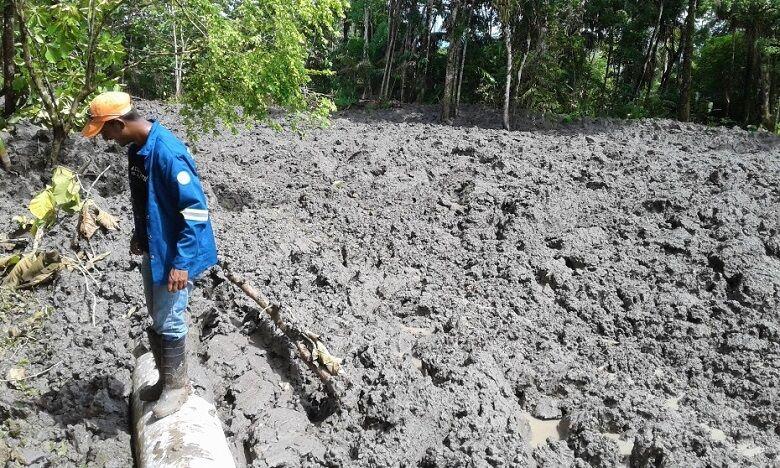 Expanding outwards: The mud volcano that erupted in Brickfield Village Moonan’s information was corroborated by village elders who recall visiting the site decades ago and seeing multiple conical vents in the forest before the woods became impenetrable and the site passed into memory. Call it Polly Maharaj
So, what caused the eruption? Faults are breaks in the rocks and can extend to significant depths in the earth. The Brickfield mud volcano is located on what geologists know as the Tabaquite fault. At depths below the Tabaquite area, there are sands with oil, gas and salt water trapped by clays. The movement on the fault allows the trap to break for an instant, allowing the water, oil and gas to escape, said Moonan, who is also vice-president of the American Association of Petroleum Geologists Latin America and Caribbean region. The fluids travel upwards to the surface where they pick up bits of rock—clay, sandstone and limestone along the way, and this is the mud flow that we see when it explodes at the surface. And although the Piparo mud volcano is nearby, it is not related to the Brickfield mud volcano since they occur on separate faults, said Moonan. Regarding the size of the eruption, Moonan said the mud flow covers an area similar to the size at Devil’s Woodyard. The team measured the maximum length of mud flow at 165 metres (a football field is 110 metres in length) and the maximum width at 76 metres. The geologists said the mud flow was expelled in a north-westerly direction along a three-degree gradient slope, with the flow turning to the north at approximately 33 metres downslope. And the estimated volume of mud expelled? It’s 1,740 cubic metres or approximately 11,000 barrels. The mud flow is much less thick than that which was observed at the Devil’s Woodyard eruption, hence the volume is significantly less. Despite this, the force of the eruption was just as damaging, felling lots of trees in its path. And for adventurers interested in seeing this natural phenomenon, there is a warning, It’s not near a road, so be prepared to hike along a forest trail, on State lands. And there will be snakes. Do not go alone. Do not go at night. Walk with water. Wear the right footwear. It’s going to be muddy. And you can call it Polly Maharaj. That’s the name of the woman who discovered it. (Source: Daily Express, July 13, 2022) It's been said that you can find a Trini everywhere, and where a carnival is, a Trinbagonian is known to be behind it. This is the case with the new carnival being born in South East Asia, Indonesia, on the island of Bali. Caribbean Vybez founder Ethan Auguste who first went to Bali in 2019, is organising this first Trinidad and Tobago-themed Carnival in the S.E.A. region. Auguste is no stranger to promoting his culture. He is also known as the pioneer who brought Caribbean culture to the United Arab Emirates back in 2009 and now in Bali. Although Reggae is no stranger to these parts, Trinidad and Tobago's Soca and Carnival is, and this was the mission of Caribbean Vybez when deciding to make Bali its new home three years ago. Bali Carnival planned from September 23 to 28, is already making waves. The event, which takes place at the new Renaissance Bali Hotel, Nusa Dua, will start with a welcome event and continue to the hotel's Atomic 13 pool venue for Glow, the all-white affair on day one. Carnival goers will then don their costumes designed by Trinidadian Aaron Schneider and produced in Bali. Revellers will take to the road for the first Carnival inspired by The Greatest Show on Earth - Trinidad and Tobago Carnival, which leads into a las lap celebration scheduled to go till late in true Trini style.
Bali Colour Festival which will run on the following day will host a special J'ouvert on the beach, followed by a Caribbean Soul Concert with a lineup of top Caribbean talents on the last day of the main activities. "It's been one of my dreams over the years to produce a carnival, and coming to Bali, I saw the potential to create not just a carnival event but an experience many other carnivals don't have in a destination people have on their bucket list. Bali Carnival would hugely boost Bali's tourism during their slower period," Auguste said via a press release. With destination events becoming popular, Auguste is confident that Bali Carnival will secure its place in the carnival calendar, one that all carnival fans would not want to miss. From steelpan to the cuisine of T&T and the Caribbean, this carnival experience promises to be a diverse and captivating affair. To join the inaugural Carnival, visit their website www.balicarnival.com and follow their Instagram @balicarnvial for updates and packages. (Source: The Loop, July 12, 2022) |
T&T news blogThe intent of this blog is to bring some news from home and other fun items. If you enjoy what you read, please leave us a comment.. Archives
May 2025
Categories
All
|
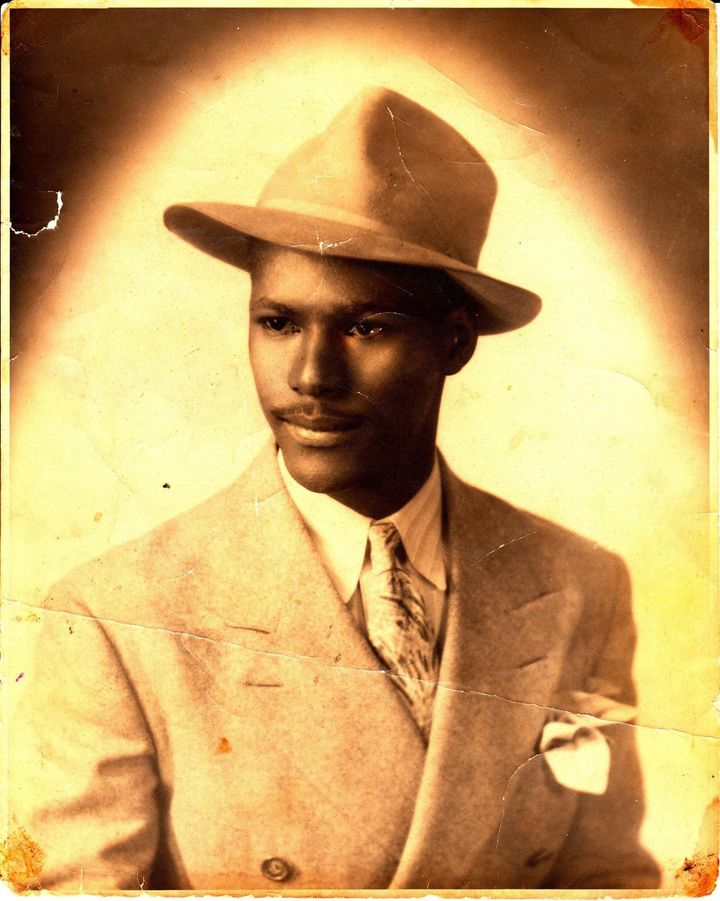
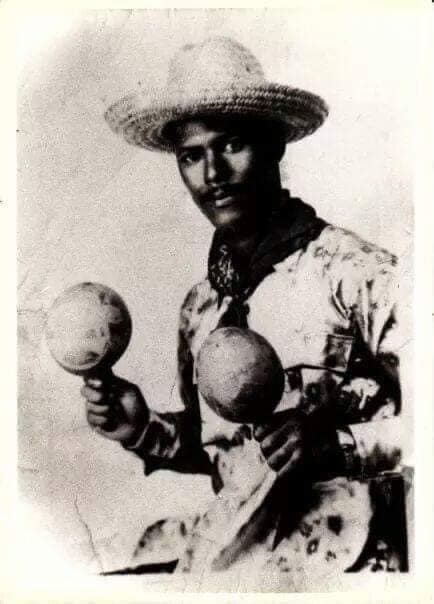

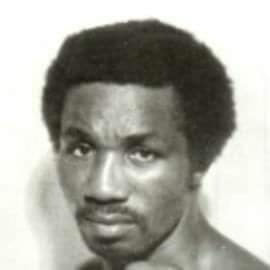
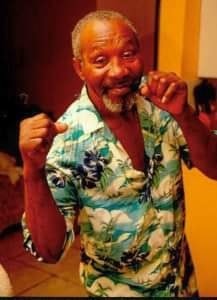
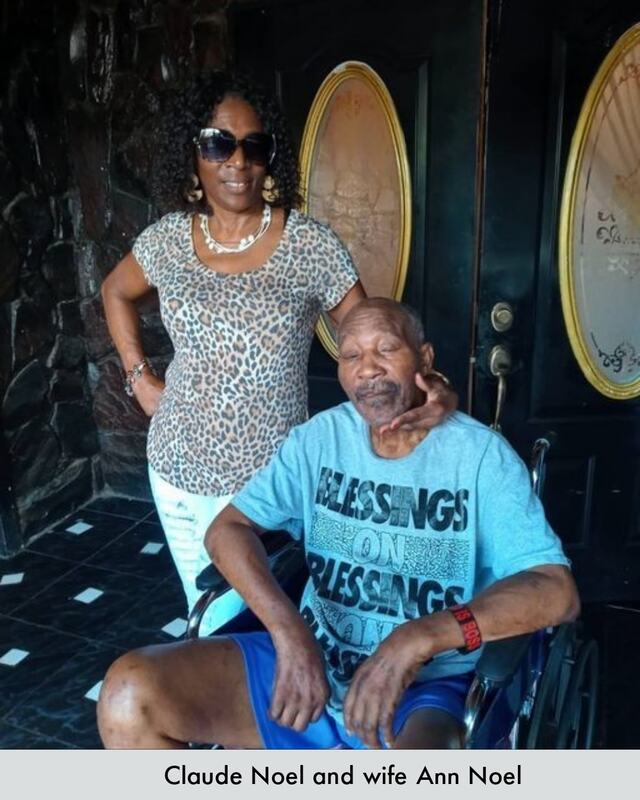
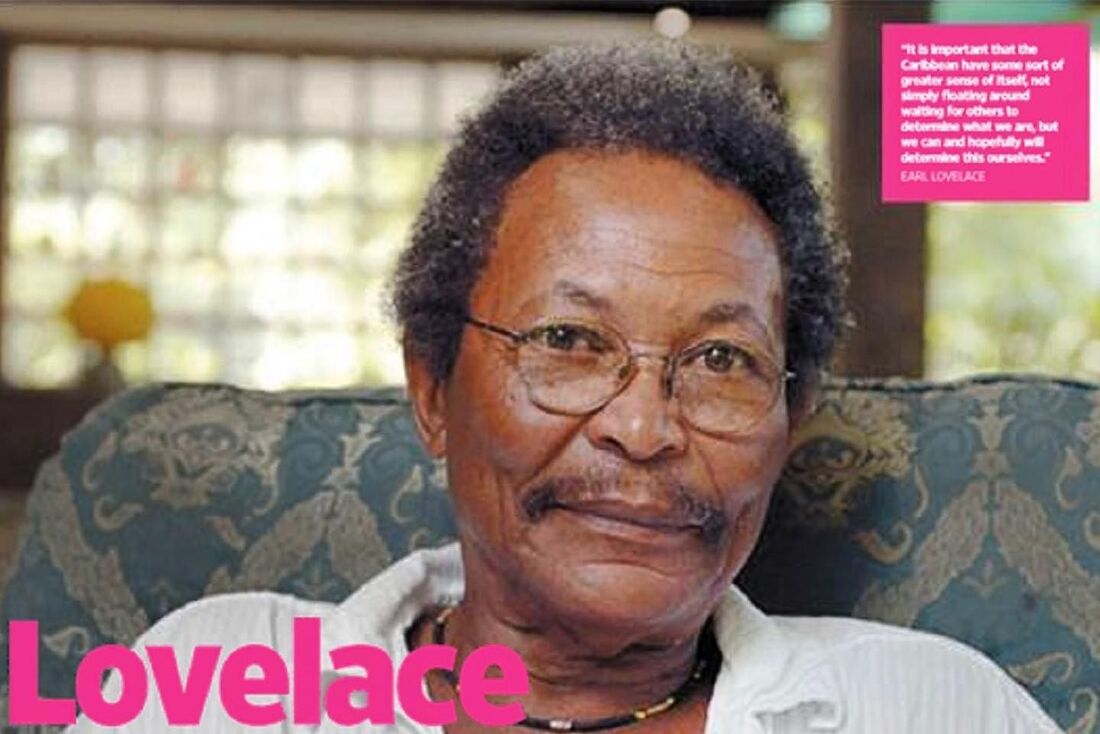

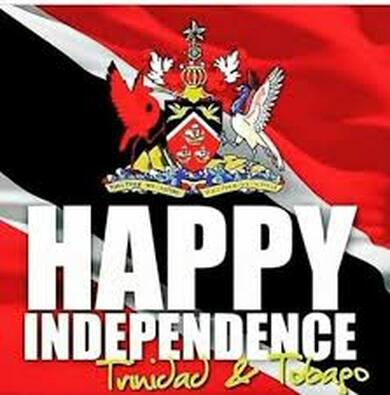
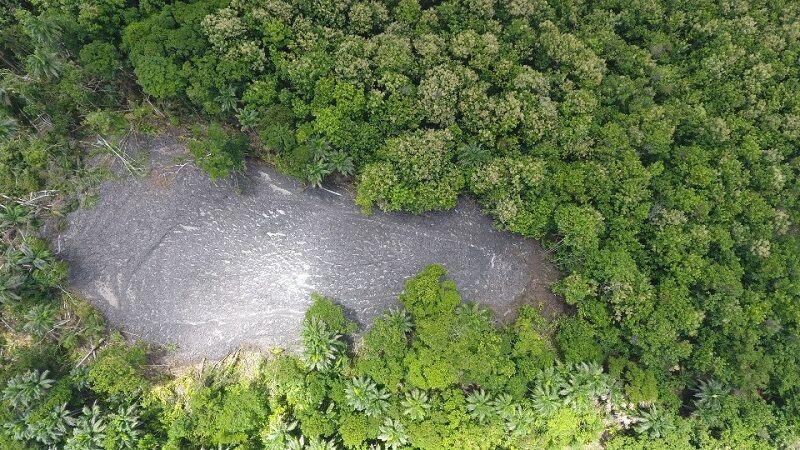
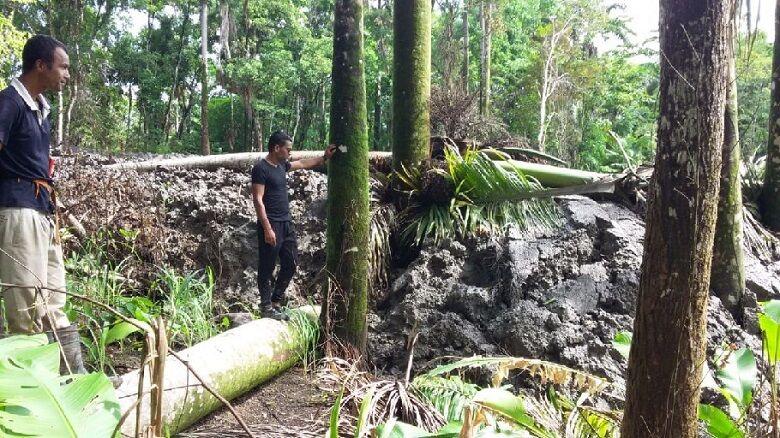


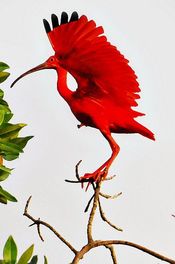
 RSS Feed
RSS Feed